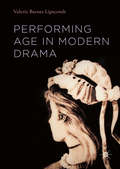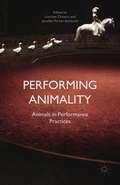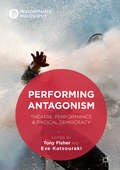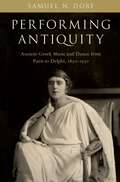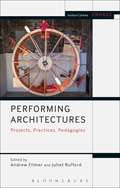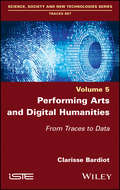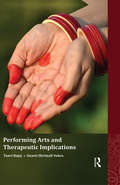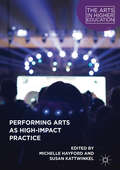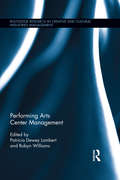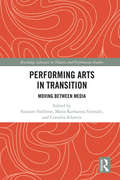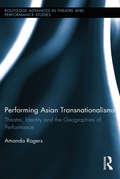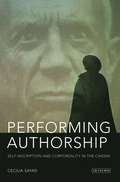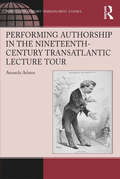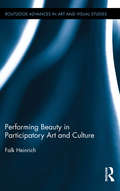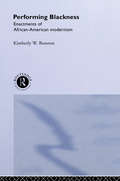- Table View
- List View
Performing Age in Modern Drama
by Valerie Barnes LipscombThis book is the first to examine age across the modern and contemporary dramatic canon, from Arthur Miller and Tennessee Williams to Paula Vogel and Doug Wright. All ages across the life course are interpreted as performance and performative both on page and on stage, including professional productions and senior-theatre groups.The common admonition "act your age" provides the springboard for this study, which rests on the premise that age is performative in nature, and that issues of age and performance crystallize in the theatre.Dramatic conventions include characters who change ages from one moment to the next, overtly demonstrating on stage the reiterated actions that create a performative illusion of stable age. Moreover, directors regularly cast actors in these plays against their chronological ages. Lipscomb contends that while the plays reflect varying attitudes toward performing age, as a whole they reveal a longing for an ageless self, a desire to present a consistent, unified identity. The works mirror prevailing social perceptions of the aging process as well as the tension between chronological age, physiological age, and cultural constructions of age.
Performing Animality: Animals in Performance Practices
by Jennifer Parker-StarbuckPerforming Animality provides theoretical and creative interventions into the presence of the animal and ideas of animality in performance. Animals have always played a part in human performance practices. Maintaining a crucial role in many communities' cultural traditions, animal-human encounters have been key in the development of performance. Similarly, performance including both living animals and/or representations of animals provides the context for encounters in which issues of power, human subjectivity and otherness are explored. Crucially, however, the inclusion of animals in performance also offers an opportunity to investigate ethical and moral assumptions about human and non-human animals. This book offers a historical and theoretical exploration of animal presence in performance by looking at the concept of animality and how it has developed in theatre and performance practices from the eighteenth century to today. Furthermore, it points to shifts in political, cultural, and ethical animal-human relations emerging within the context of animality and performance.
Performing Antagonism: Theatre, Performance & Radical Democracy (Performance Philosophy)
by Tony Fisher Eve KatsourakiThis book combines performance analysis with contemporary political philosophy to advance new ways of understanding both political performance and the performativity of the politics of the street.Our times are pre-eminently political times and have drawn radical responses from many theatre and performance practitioners. However, a decade of conflict in the Middle East and Afghanistan, the eruption of new social movements around the world, the growth of anti-capitalist and anti-globalisation struggles, the upsurge of protests against the blockades of neoliberalism, and the rising tide of dissent and anger against corporate power, with its exorbitant social costs, have left theatre and performance scholarship confronting something of a dilemma: how to theorize the political antagonisms of our day? Drawing on the resources of ‘post-Marxist’ political thinkers such as Chantal Mouffe and Jacques Rancière, the book explores how new theoretical horizons have been made available for performance analysis.
Performing Antiquity: Ancient Greek Music and Dance from Paris to Delphi, 1890-1930
by Samuel N. DorfPerforming Antiquity: Ancient Greek Music and Dance from Paris to Delphi, 1890-1930 investigates collaborations between French and American scholars of Greek antiquity (archaeologists, philologists, classicists, and musicologists), and the performing artists (dancers, composers, choreographers and musicians) who brought their research to life at the birth of Modernism. The book tells the story of performances taking place at academic conferences, the Paris Opéra, ancient amphitheaters in Delphi, and private homes. These musical and dance collaborations are built on reciprocity: the performers gain new insight into their craft while learning new techniques or repertoire and the scholars gain an opportunity to bring theory into experimental practice, that is, they have a chance see/hear/experience what they have studied and imagined. The performers receive the imprimatur of scholarship, the stamp of authenticity, and validation for their creative activities. Drawing from methods and theory from musicology, dance studies, performance studies, queer studies, archaeology, classics and art history the book shows how new scholarly methods and technologies altered the performance, and, ultimately, the reception of music and dance of the past. Acknowledging and critically examining the complex relationships performers and scholars had with the pasts they studied does not undermine their work. Rather, understanding our own limits, biases, dreams, obsessions, desires, loves, and fears enriches the ways we perform the past.
Performing Antiquity: Ancient Greek Music and Dance from Paris to Delphi, 1890-1930
by Samuel N. DorfPerforming Antiquity: Ancient Greek Music and Dance from Paris to Delphi, 1890-1930 investigates collaborations between French and American scholars of Greek antiquity (archaeologists, philologists, classicists, and musicologists), and the performing artists (dancers, composers, choreographers and musicians) who brought their research to life at the birth of Modernism. The book tells the story of performances taking place at academic conferences, the Paris Opéra, ancient amphitheaters in Delphi, and private homes. These musical and dance collaborations are built on reciprocity: the performers gain new insight into their craft while learning new techniques or repertoire and the scholars gain an opportunity to bring theory into experimental practice, that is, they have a chance see/hear/experience what they have studied and imagined. The performers receive the imprimatur of scholarship, the stamp of authenticity, and validation for their creative activities. Drawing from methods and theory from musicology, dance studies, performance studies, queer studies, archaeology, classics and art history the book shows how new scholarly methods and technologies altered the performance, and, ultimately, the reception of music and dance of the past. Acknowledging and critically examining the complex relationships performers and scholars had with the pasts they studied does not undermine their work. Rather, understanding our own limits, biases, dreams, obsessions, desires, loves, and fears enriches the ways we perform the past.
Performing Architectures: Projects, Practices, Pedagogies (Methuen Drama Engage)
by Andrew Filmer Juliet RuffordPerforming Architectures offers a coherent introduction to the fields of performance and contemporary architecture, exploring the significance of architecture for performance theory and theatre and performance practice. It maps the diverse relations that exist between these disciplines and demonstrates how their aims, concerns and practices overlap through shared interests in space, action and event. Through a wide range of international examples and contributions from scholars and practitioners, it offers readers an analytical survey of current practices and equips them with the tools for analyzing site-specific and immersive theatre and performance.The essays in this volume, contributed by leading theorists and practitioners from both disciplines, focus on three key sites of encounter:* Projects: examines recent trends in architecture for performance; * Practices: looks at cross-currents in artistic practice, including spatial dramaturgies, performance architectonics and performative architectures; and * Pedagogies: considers the uses of performance in architectural education and architecture in teaching performance.The volume provides an essential introduction to the ways in which performance and architecture, as socio-spatial processes and as things made or constructed, operate as generating, shaping and steering forces in understanding and performing the other.
Performing Architectures: Projects, Practices, Pedagogies (Methuen Drama Engage)
by Andrew Filmer Juliet RuffordPerforming Architectures offers a coherent introduction to the fields of performance and contemporary architecture, exploring the significance of architecture for performance theory and theatre and performance practice. It maps the diverse relations that exist between these disciplines and demonstrates how their aims, concerns and practices overlap through shared interests in space, action and event. Through a wide range of international examples and contributions from scholars and practitioners, it offers readers an analytical survey of current practices and equips them with the tools for analyzing site-specific and immersive theatre and performance.The essays in this volume, contributed by leading theorists and practitioners from both disciplines, focus on three key sites of encounter:* Projects: examines recent trends in architecture for performance; * Practices: looks at cross-currents in artistic practice, including spatial dramaturgies, performance architectonics and performative architectures; and * Pedagogies: considers the uses of performance in architectural education and architecture in teaching performance.The volume provides an essential introduction to the ways in which performance and architecture, as socio-spatial processes and as things made or constructed, operate as generating, shaping and steering forces in understanding and performing the other.
Performing Arts and Digital Humanities: From Traces to Data
by Clarisse BardiotDigital traces, whether digitized (programs, notebooks, drawings, etc.) or born digital (emails, websites, video recordings, etc.), constitute a major challenge for the memory of the ephemeral performing arts.Digital technology transforms traces into data and, in doing so, opens them up to manipulation. This paradigm shift calls for a renewal of methodologies for writing the history of theater today, analyzing works and their creative process, and preserving performances. At the crossroads of performing arts studies, the history, digital humanities, conservation and archiving, these methodologies allow us to take into account what is generally dismissed, namely, digital traces that are considered too complex, too numerous, too fragile, of dubious authenticity, etc.With the analysis of Merce Cunningham’s digital traces as a guideline, and through many other examples, this book is intended for researchers and archivists, as well as artists and cultural institutions.
Performing Arts and Digital Humanities: From Traces to Data
by Clarisse BardiotDigital traces, whether digitized (programs, notebooks, drawings, etc.) or born digital (emails, websites, video recordings, etc.), constitute a major challenge for the memory of the ephemeral performing arts.Digital technology transforms traces into data and, in doing so, opens them up to manipulation. This paradigm shift calls for a renewal of methodologies for writing the history of theater today, analyzing works and their creative process, and preserving performances. At the crossroads of performing arts studies, the history, digital humanities, conservation and archiving, these methodologies allow us to take into account what is generally dismissed, namely, digital traces that are considered too complex, too numerous, too fragile, of dubious authenticity, etc.With the analysis of Merce Cunningham’s digital traces as a guideline, and through many other examples, this book is intended for researchers and archivists, as well as artists and cultural institutions.
Performing Arts and Therapeutic Implications
by Tanvi Bajaj Swasti Shrimali VohraPresenting an alternative perspective, this book proposes that performing arts forge an emotional bond between the performer and the audience, making the act of performance a therapeutic and restorative experience, and not merely recreational. Studying the life-experiences of six artists, and their unique engagement with three art forms — music, drama and dance — the book highlights the physical, emotional, mental, and spiritual effects of performing arts both on the performers and the audience. More importantly, it takes the current understanding of the therapeutic role of arts beyond a deficit model of health that focuses on their use in curing illnesses, disabilities and imbalances, towards a more positive growth-centric model that relates them to promoting holistic mental health, well-being and happiness. It thus bridges the gap between the theoretical understanding of creative arts therapy and the practical experience of performing arts in non-therapeutic settings. Further, it assumes increasing relevance with respect to fast-changing lifestyles to which stress and ill-health are often attributed. The book will appeal to artists, educators and researchers of performing arts, applied psychology, counselling and therapy, and cultural studies, as well as interested general readers.
Performing Arts and Therapeutic Implications
by Tanvi Bajaj Swasti Shrimali VohraPresenting an alternative perspective, this book proposes that performing arts forge an emotional bond between the performer and the audience, making the act of performance a therapeutic and restorative experience, and not merely recreational. Studying the life-experiences of six artists, and their unique engagement with three art forms — music, drama and dance — the book highlights the physical, emotional, mental, and spiritual effects of performing arts both on the performers and the audience. More importantly, it takes the current understanding of the therapeutic role of arts beyond a deficit model of health that focuses on their use in curing illnesses, disabilities and imbalances, towards a more positive growth-centric model that relates them to promoting holistic mental health, well-being and happiness. It thus bridges the gap between the theoretical understanding of creative arts therapy and the practical experience of performing arts in non-therapeutic settings. Further, it assumes increasing relevance with respect to fast-changing lifestyles to which stress and ill-health are often attributed. The book will appeal to artists, educators and researchers of performing arts, applied psychology, counselling and therapy, and cultural studies, as well as interested general readers.
Performing Arts as High-Impact Practice (The\arts In Higher Education Ser.)
by Michelle Hayford Susan KattwinkelThis book investigates how the performing arts in higher education nationally contribute to the “high impact practices,” as identified by the Association of American Colleges and Universities (AACU). Using the well-known map of the HIPs for illustrating the centrality of performing arts practices in higher education, the editors and authors of this volume call for increased participation by performing arts programs in general education and campus initiatives, with specific case studies as a guide. Performing arts contribute to the efforts of their institution in delivering a strong liberal arts education that uniquely serves students to meet the careers of the future. This is the first book to explicitly link the performing arts to the HIPs, and will result in the implementation of best practices to better meet the educational needs of students. At stake is the viability of performing arts programs to continue to serve students in their pursuit of a liberal arts education.
Performing Arts as High-Impact Practice (The Arts in Higher Education)
by Michelle Hayford Susan KattwinkelThis book investigates how the performing arts in higher education nationally contribute to the “high impact practices,” as identified by the Association of American Colleges and Universities (AACU). Using the well-known map of the HIPs for illustrating the centrality of performing arts practices in higher education, the editors and authors of this volume call for increased participation by performing arts programs in general education and campus initiatives, with specific case studies as a guide. Performing arts contribute to the efforts of their institution in delivering a strong liberal arts education that uniquely serves students to meet the careers of the future. This is the first book to explicitly link the performing arts to the HIPs, and will result in the implementation of best practices to better meet the educational needs of students. At stake is the viability of performing arts programs to continue to serve students in their pursuit of a liberal arts education.
Performing Arts Center Management (Routledge Research in the Creative and Cultural Industries)
by Patricia Dewey Lambert Robyn WilliamsPerforming arts centers (PACs) are an integral part of the cultural and creative industries, significantly influencing the cultural, social, and economic vitality of communities around the world. Virtually all PACs are community-based and serve the public interest, whether structured as a public, nonprofit, for-profit, or hybrid entity. However, there is a lack of knowledge about the important community role of performing arts centers, especially those that mainly host and present work produced by other arts organizations. This gap is startling, given the ubiquitous presence of PACs in urban centers, small communities, as well as colleges and universities. This co-edited reference book provides valuable information at the intersection of theory and practice in the professional field of executive leadership of performing arts centers. Drawing on the expertise of leading academics, consultants, and executives, this book focuses on institutions and practices in the United States, and is contextualized within additional fields such as cultural planning, urban revitalization, and economic development. Performing Arts Center Management aims to provide valuable theoretical, conceptual, empirical, and practice-based information to current and future leaders in creative and cultural industries management. It serves as a unique reference for researchers, university students, civic leaders, urban planners, public venue managers, and arts administrators aspiring to improve or advance their work in successfully managing performing arts centers.
Performing Arts Center Management (Routledge Research in the Creative and Cultural Industries)
by Patricia Dewey Lambert Robyn WilliamsPerforming arts centers (PACs) are an integral part of the cultural and creative industries, significantly influencing the cultural, social, and economic vitality of communities around the world. Virtually all PACs are community-based and serve the public interest, whether structured as a public, nonprofit, for-profit, or hybrid entity. However, there is a lack of knowledge about the important community role of performing arts centers, especially those that mainly host and present work produced by other arts organizations. This gap is startling, given the ubiquitous presence of PACs in urban centers, small communities, as well as colleges and universities. This co-edited reference book provides valuable information at the intersection of theory and practice in the professional field of executive leadership of performing arts centers. Drawing on the expertise of leading academics, consultants, and executives, this book focuses on institutions and practices in the United States, and is contextualized within additional fields such as cultural planning, urban revitalization, and economic development. Performing Arts Center Management aims to provide valuable theoretical, conceptual, empirical, and practice-based information to current and future leaders in creative and cultural industries management. It serves as a unique reference for researchers, university students, civic leaders, urban planners, public venue managers, and arts administrators aspiring to improve or advance their work in successfully managing performing arts centers.
Performing Arts in Transition: Moving between Media (Routledge Advances in Theatre & Performance Studies)
by Susanne Foellmer Cornelia Schmitz Katharina SchmidtArtists especially from dance and performance art as well as opera are involved to an increasing degree in the transfer between different media, not only in their productions but also the events, materials, and documents that surround them. At the same time, the focus on that which remains has become central to any discussion of performance. Performing Arts in Transition explores what takes place in the moments of transition from one medium to another, and from the live performance to that which "survives" it. Case studies from a broad range of interdisciplinary scholars address phenomena such as: The dynamics of transfer between the performing and visual arts. The philosophy and terminologies of transitioning between media. Narratives and counternarratives in historical re-creations. The status of chronology and the document in art scholarship. This is an essential contribution to a vibrant, multidisciplinary and international field of research emerging at the intersections of performance, visual arts, and media studies.
Performing Arts in Transition: Moving between Media (Routledge Advances in Theatre & Performance Studies)
by Susanne Foellmer Cornelia Schmitz Katharina SchmidtArtists especially from dance and performance art as well as opera are involved to an increasing degree in the transfer between different media, not only in their productions but also the events, materials, and documents that surround them. At the same time, the focus on that which remains has become central to any discussion of performance. Performing Arts in Transition explores what takes place in the moments of transition from one medium to another, and from the live performance to that which "survives" it. Case studies from a broad range of interdisciplinary scholars address phenomena such as: The dynamics of transfer between the performing and visual arts. The philosophy and terminologies of transitioning between media. Narratives and counternarratives in historical re-creations. The status of chronology and the document in art scholarship. This is an essential contribution to a vibrant, multidisciplinary and international field of research emerging at the intersections of performance, visual arts, and media studies.
Performing Asian Transnationalisms: Theatre, Identity, and the Geographies of Performance (Routledge Advances in Theatre & Performance Studies)
by Amanda RogersThis book makes a significant contribution to interdisciplinary engagements between Theatre Studies and Cultural Geography in its analysis of how theatre articulates transnational geographies of Asian culture and identity. Deploying a geographical approach to transnational culture, Rogers analyses the cross-border relationships that exist within and between Asian American, British East Asian, and South East Asian theatres, investigating the effect of transnationalism on the construction of identity, the development of creative praxis, and the reception of works in different social fields. This book therefore examines how practitioners engage with one another across borders, and details the cross-cultural performances, creative opportunities, and political alliances that result. By viewing ethnic minority theatres as part of global — rather than simply national — cultural fields, Rogers argues that transnational relationships take multiple forms and have varying impetuses that cannot always be equated to diasporic longing for a homeland or as strategically motivated for economic gain. This argument is developed through a series of chapters that examine how different transnational spatialities are produced and re-worked through the practice of theatre making, drawing upon an analysis of rehearsals, performances, festivals, and semi-structured interviews with practitioners. The book extends existing discussions of performance and globalization, particularly through its focus on the multiplicity of transnational spatiality and the networks between English-language Asian theatres. Its analysis of spatially extensive relations also contributes to an emerging body of research on creative geographies by situating theatrical praxis in relation to cross-border flows. Performing Asian Transnationalisms demonstrates how performances reflect and rework conventional transnational geographies in imaginative and innovative ways.
Performing Asian Transnationalisms: Theatre, Identity, and the Geographies of Performance (Routledge Advances in Theatre & Performance Studies)
by Amanda RogersThis book makes a significant contribution to interdisciplinary engagements between Theatre Studies and Cultural Geography in its analysis of how theatre articulates transnational geographies of Asian culture and identity. Deploying a geographical approach to transnational culture, Rogers analyses the cross-border relationships that exist within and between Asian American, British East Asian, and South East Asian theatres, investigating the effect of transnationalism on the construction of identity, the development of creative praxis, and the reception of works in different social fields. This book therefore examines how practitioners engage with one another across borders, and details the cross-cultural performances, creative opportunities, and political alliances that result. By viewing ethnic minority theatres as part of global — rather than simply national — cultural fields, Rogers argues that transnational relationships take multiple forms and have varying impetuses that cannot always be equated to diasporic longing for a homeland or as strategically motivated for economic gain. This argument is developed through a series of chapters that examine how different transnational spatialities are produced and re-worked through the practice of theatre making, drawing upon an analysis of rehearsals, performances, festivals, and semi-structured interviews with practitioners. The book extends existing discussions of performance and globalization, particularly through its focus on the multiplicity of transnational spatiality and the networks between English-language Asian theatres. Its analysis of spatially extensive relations also contributes to an emerging body of research on creative geographies by situating theatrical praxis in relation to cross-border flows. Performing Asian Transnationalisms demonstrates how performances reflect and rework conventional transnational geographies in imaginative and innovative ways.
Performing Authorship: Self-Inscription and Corporeality in the Cinema (World Cinema)
by Cecilia SayadThe figure of the auteur continues to haunt the study of film, resisting both the poststructuralist charges that pointed to its absence and the histories of production that have described its pitfalls. In an era defined by the instability of identities and the recycling of works, Performing Authorship offers a refreshingly new take on the cinematic auteur, proposing that the challenges that once accelerated this figure's critical demise should instead pump new life into it. This book is about the drama of creative processes in essay, documentary and fiction films, with particular emphasis on the effects that the filmmaker's body exerts on our sense of an authorial presence. It is an illuminating analysis of films by Jean-Luc Godard, Woody Allen, Agnès Varda, Orson Welles, Jean Rouch, Eduardo Coutinho and Sarah Turner that shows directors shifting between opposite movements towards exposure and masking, oscillating between the assertion and divestiture of their authorial control. In the process, Cecilia Sayad argues, the film author is not necessarily at the work's origin, nor does it constitute the end product. What this new concept of performing authorship describes is the making and unmaking of a subject.
Performing Authorship in the Nineteenth-Century Transatlantic Lecture Tour (Ashgate Series in Nineteenth-Century Transatlantic Studies)
by Amanda AdamsExpanding our understanding of what it meant to be a nineteenth-century author, Amanda Adams takes up the concept of performative, embodied authorship in relationship to the transatlantic lecture tour. Adams argues that these tours were a central aspect of nineteenth-century authorship, at a time when authors were becoming celebrities and celebrities were international. Spanning the years from 1834 to 1904, Adams’s book examines the British lecture tours of American authors such as Frederick Douglass, Harriet Beecher Stowe, and Mark Twain, and the American lecture tours of British writers that include Harriet Martineau, Charles Dickens, Oscar Wilde, and Matthew Arnold. Adams concludes her study with a discussion of Henry James, whose American lecture tour took place after a decades-long absence. In highlighting the wide range of authors who participated in this phenomenon, Adams makes a case for the lecture tour as a microcosm for nineteenth-century authorship in all its contradictions and complexity.
Performing Authorship in the Nineteenth-Century Transatlantic Lecture Tour (Ashgate Series in Nineteenth-Century Transatlantic Studies)
by Amanda AdamsExpanding our understanding of what it meant to be a nineteenth-century author, Amanda Adams takes up the concept of performative, embodied authorship in relationship to the transatlantic lecture tour. Adams argues that these tours were a central aspect of nineteenth-century authorship, at a time when authors were becoming celebrities and celebrities were international. Spanning the years from 1834 to 1904, Adams’s book examines the British lecture tours of American authors such as Frederick Douglass, Harriet Beecher Stowe, and Mark Twain, and the American lecture tours of British writers that include Harriet Martineau, Charles Dickens, Oscar Wilde, and Matthew Arnold. Adams concludes her study with a discussion of Henry James, whose American lecture tour took place after a decades-long absence. In highlighting the wide range of authors who participated in this phenomenon, Adams makes a case for the lecture tour as a microcosm for nineteenth-century authorship in all its contradictions and complexity.
Performing Beauty in Participatory Art and Culture (Routledge Advances in Art and Visual Studies)
by Falk HeinrichThis book investigates the notion of beauty in participatory art, an interdisciplinary form that necessitates the audience’s agential participation and that is often seen in interactive art and technology-driven media installations. After considering established theories of beauty, for example, Plato, Alison, Hume, Kant, Gadamer and Santayana through to McMahon and Sartwell, Heinrich argues that the experience of beauty in participatory art demands a revised notion of beauty; a conception that accounts for the performative and ludic turn within various art forms and which is, in a broader sense, a notion of beauty suited to a participatory and technology-saturated culture. Through case studies of participatory art, he provides an art-theoretical approach to the concept of performative beauty; an approach that is then applied to the wider context of media and design artefacts.
Performing Beauty in Participatory Art and Culture (Routledge Advances in Art and Visual Studies)
by Falk HeinrichThis book investigates the notion of beauty in participatory art, an interdisciplinary form that necessitates the audience’s agential participation and that is often seen in interactive art and technology-driven media installations. After considering established theories of beauty, for example, Plato, Alison, Hume, Kant, Gadamer and Santayana through to McMahon and Sartwell, Heinrich argues that the experience of beauty in participatory art demands a revised notion of beauty; a conception that accounts for the performative and ludic turn within various art forms and which is, in a broader sense, a notion of beauty suited to a participatory and technology-saturated culture. Through case studies of participatory art, he provides an art-theoretical approach to the concept of performative beauty; an approach that is then applied to the wider context of media and design artefacts.
Performing Blackness: Enactments of African-American Modernism
by Kimberley W. BenstonPerforming Blackness offers a challenging interpretation of black cultural expression since the Black Arts Movement of the 1960s. Exploring drama, music, poetry, sermons, and criticism, Benston offers an exciting meditation on modern black performance's role in realising African-American aspirations for autonomy and authority. Artists covered include: * John Coltrane* Ntozake Shange * Ed Bullins * Amiri Baraka * Adrienne Kennedy * Michael Harper. Performing Blackness is an exciting contribution to the ongoing debate about the vitality and importance of black culture.
